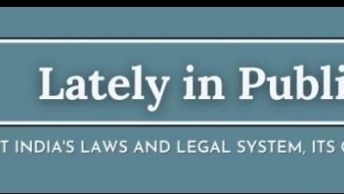[As part of our New Scholarship section, we have been inviting discussants to respond to the public law-themed articles featured in Volume 5 the Indian Law Review. You can access all the posts in this discussion here. In this post, Gale Andrew responds to Dr. Farzana Akter’s paper titled ‘The Standard of Assistance From Legal Aid Lawyers: An Indian Perspective”. A small summary of the Paper can be accessed here.]
Farzana Akter makes an important contribution to the discourse on the quality of legal aid provided in India. In this article, she documents the international and domestic standards governing the standards of assistance provided by legal aid lawyers, and the extent to which the reality of legal aid provided in India fails to comply. While the article represents an essential step in engaging more deeply with quality of legal aid, I argue that a few fundamental questions remain to be answered for a more holistic engagement on the issue of quality of legal assistance.
The article identifies certain key aspects that constitute minimum standards of assistance that ought to be provided by legal aid lawyers. These include effective communication with clients, addressing corruption among lawyers, and developing institutional processes to review performance of advocates regularly. Addressing each of these is essential to any reform to improve the effectiveness of the legal aid system. While the scope of the paper was limited to specific issues in the quality of legal aid, I argue that a few additional questions emerge that require further research before any reform is instituted. More specifically, these include engaging with performance in court and with the performance of private lawyers towards ensuring the needs and interests of marginalised communities are well-protected.
Performance in Court
One key issue that receives comparatively little attention in the article is that of performance of legal aid lawyers in court. While engagement with the client is undoubtedly fundamental to performance as an advocate, particularly when addressing the needs of marginalised populations the legal aid system is intended to serve, the prevailing discourse on the poor performance of legal aid lawyers has in fact focused on representation in court.
Despite this attention, there has been little effort to define any minimum standards of representation that could be the basis of such an assessment in a systematic manner. Similarly, engagement by the judiciary has been inconsistent and insufficient in defining the scope of effective legal assistance. While the article raises the importance of processes such as the Monitoring and Mentoring Committees to evaluate performance, without any standards against which performance is assessed, monitoring and review of performance of lawyers will remain ad hoc and arbitrary.
Not Just a Legal Aid Issue
The second issue that emerges is the choice to focus solely on standards of assistance of legal aid lawyers. Engaging with minimum standards of legal assistance, particularly in India, must necessarily also involve addressing representation provided by private lawyers as well.
As the article notes, the Death Penalty India Report (“DPIR”) found that around 30% of prisoners sentenced to death relied on a legal aid lawyer at the trial court level with the remaining relying on private representation. However, the quality concerns highlighted in the DPIR, such as of lawyers failing to engage with their clients, were in no way limited to legal aid lawyers. The problems highlighted by the present article in fact appear to pervade both private and legal aid representation. This assumes significance in light of the issue of underutilisation of legal aid, as highlighted in the DPIR.
Subsequent research we published has revealed that less than 8% of undertrials admitted into prison utilised the legal aid they were entitled to. However, a majority of undertrials are also socio-economically vulnerable per the National Crime Records Bureau. While there is no definitive evidence of the causes for this phenomenon, anecdotal evidence indicates it is, at least partly, due to the mistrust of the quality of the legal aid system. This results in a largely socio-economically vulnerable population exhausting their limited income and resources to secure private representation. Protecting the right to fair trial of such marginalised populations, thus, requires addressing the quality of representation provided by both private and legal aid lawyers to have any real effect, at least until underutilisation is addressed.
In raising these questions, I do not claim that the standards or concerns are the same for private and legal aid lawyers. Legal aid lawyers essentially fulfil the state function of ensuring vulnerable sections of society are adequately represented in court and have equal access to justice. In such a role, it is reasonable for us to imagine different standards for legal aid and private representation. But while developing such standards, it is also important to recognise that the malaise sought to be addressed is far more pervasive than just that of the legal aid system.
Unanswered Questions
Ultimately however, the concern is that we just understand too little of the system and how it functions, to be able to develop any accurate assessment of the causes, let alone the solutions for such concerns. While we remain unclear on the meaning of standard of assistance, that is, on what constitutes such poor quality of representation that it requires redressal by the state, we cannot diagnose what might be influencing such gaps in quality. If we do not know the causes for such problems, we cannot even begin to identify solutions to the same. For instance, the article focuses on the lack of financial incentives influencing the quality of performance among legal aid lawyers, with specific critiques of the low honorariums and delayed payments as influencing the reality of inadequate representation. While these issues might influence performance in some capacity, we understand too little of the nature of quality of representation and the factors influencing it to make such a determination.
The reality of the widespread problems of poor quality of representation raises serious questions about this focus on performance incentives as the silver bullet to improve quality. For instance, if the financial incentive was the only concern, then there would be a marked difference in the quality of representation provided by private lawyers, which does not appear to be the case. Concerns with quality cannot be resolved only through financial incentives but requires deeper engagement on the nature of training provided to and performance standards required of all lawyers.
Concluding Thoughts
It is clear that the legal aid system in India is in crisis with the massive underutilisation indicative of the perception of its quality. The article represents a crucial step in engaging with the issues of quality with the system, but questions remain that must be addressed for any reform to be effective. To begin with, we cannot see this only as a legal aid problem. Instead, we must develop and enforce minimum standards of representation across both private and legal aid representation if we are to truly protect the rights and interests of marginalised populations. As a first step, urgent research is necessary that would help us more accurately diagnose the problem and identify holistic and effective solutions. The article brings to light the importance and urgency of providing quality legal aid to our most vulnerable communities, and it is time we make the necessary effort to truly ensure equal justice for all.
Gale graduated in Law from the National Law University (NLU), Delhi in 2018 and completed her Masters in Law in Human Rights, Conflict and Justice from the School of Oriental and African Studies, University of London in 2019. As a student at NLU Delhi, she was part of the core team that worked on the Death Penalty India Report (2016). Since joining Project 39A in 2019, she has been involved in research on legal aid, bail and the death penalty. As a part of Project 39A, she helped undertake performance audits of the Supreme Court Legal Service Committee and has undertaken research on the underutilisation of legal aid system in India.







Can you be more specific about the content of your article? After reading it, I still have some doubts. Hope you can help me.
Thanks for sharing. I read many of your blog posts, cool, your blog is very good.